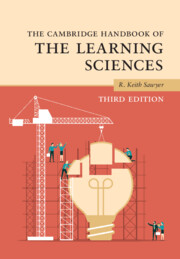Book contents
- The Cambridge Handbook of the Learning Sciences
- The Cambridge Handbook of the Learning Sciences
- Copyright page
- Contents
- Figures
- Tables
- Contributors
- Preface
- 1 An Introduction to the Learning Sciences
- Part I Foundations
- Part II Methodologies
- 9 Design-Based Research
- 10 Analyzing Collaboration
- 11 Microgenetic Methods
- 12 A Learning Sciences Perspective on the Design and Use of Assessment in Education
- 13 Learning Analytics and Educational Data Mining
- Part III Grounding Technology in the Learning Sciences
- Part IV Learning Together
- Part V Learning Disciplinary Knowledge
- Part VI Moving Learning Sciences Research into the Classroom
- Index
- References
13 - Learning Analytics and Educational Data Mining
from Part II - Methodologies
Published online by Cambridge University Press: 14 March 2022
- The Cambridge Handbook of the Learning Sciences
- The Cambridge Handbook of the Learning Sciences
- Copyright page
- Contents
- Figures
- Tables
- Contributors
- Preface
- 1 An Introduction to the Learning Sciences
- Part I Foundations
- Part II Methodologies
- 9 Design-Based Research
- 10 Analyzing Collaboration
- 11 Microgenetic Methods
- 12 A Learning Sciences Perspective on the Design and Use of Assessment in Education
- 13 Learning Analytics and Educational Data Mining
- Part III Grounding Technology in the Learning Sciences
- Part IV Learning Together
- Part V Learning Disciplinary Knowledge
- Part VI Moving Learning Sciences Research into the Classroom
- Index
- References
Summary
In recent years, the use of analytics and data mining – methodologies that extract useful information from large datasets – has become commonplace in science and business. When these methods are used in education, they are referred to as learning analytics (LA) and educational data mining (EDM). For example, adaptive learning platforms – those that respond uniquely to each learner – require learning analytics to model the learner’s current state of knowledge. The researcher can conduct second-by-second analyses of phenomena that occur over long periods of time or in an individual learning session. Large datasets are required for these analyses. In most cases, the data are gathered automatically – such as keystrokes, eye movement, or assessments – and are analyzed using algorithms based in learning sciences research. This chapter reviews prediction methods, structure discovery, relationship mining, and discovery with models.
Keywords
- Type
- Chapter
- Information
- The Cambridge Handbook of the Learning Sciences , pp. 259 - 278Publisher: Cambridge University PressPrint publication year: 2022
References
- 7
- Cited by

